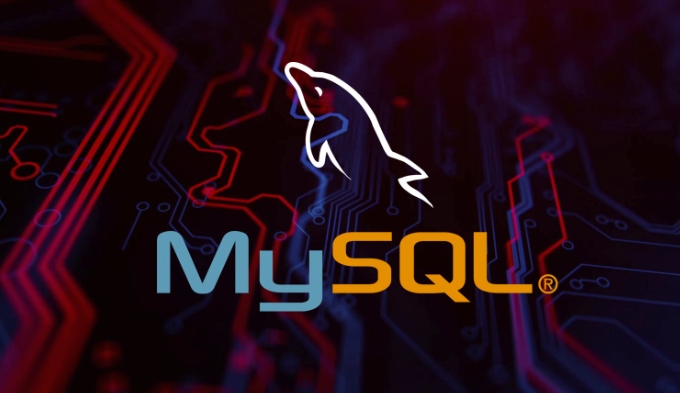MySQL provides a method to terminate running a connection or query. First, check the active thread through SHOW PROCESSLIST and get the thread ID; then use KILL [thread_id] to terminate the specified thread, but pay attention to permissions, termination delay and data consistency issues; it is recommended to check abnormal connections regularly with monitoring tools, and set a timeout mechanism in automated scripts to avoid blockage.

MySQL itself does not have "kill process" operations like the operating system, but it does provide a way to terminate a running database connection or query. If you encounter a stuck query, an operation that has not responded for a long time, or want to actively end a task, you can handle it in the following ways.

View the currently running process
In MySQL, each connection and query in execution corresponds to a thread. You can view all currently active threads through SHOW PROCESSLIST command. This command lists the ID, user, host, database, status, and execution commands of each thread.
SHOW PROCESSLIST;
Among the returned results, focus on several fields:

- Id : A thread unique identifier, which you need to use later to "kill" the process.
- User : The user who initiated the request.
- Host : Client source address.
- Command : The type of command currently executed (such as Query, Sleep, etc.).
- Time : The time (seconds) of the thread in its current state.
- State : The current state of the thread.
- Info : The SQL statement currently being executed (if any).
If you see a query running for a long time, or you are sure it is the source of the problem, you can consider "killing it".
Use the kill command to terminate the process
Once you have found the thread ID you want to terminate, you can use the KILL command to end it. The syntax is simple:

KILL [thread_id];
For example, to terminate a thread with ID 12345:
KILL 12345;
A few things to note:
- Only users with
PROCESSpermission can see all threads, otherwise they can only see their own user connections. - Execution of
KILLis not to interrupt immediately, but to notify the thread to exit as soon as possible. In some cases (such as large transaction rollback), it may take some time to wait. - If you are not sure about the scope of the impact, it is recommended to confirm whether the thread is performing critical write operations to avoid data inconsistencies.
Practical Suggestions and Common Scenarios
Sometimes you may encounter the following situations:
- A query is stuck, causing other operations to be blocked.
- The application does not close the connection correctly, and a large number of connection accumulation in Sleep states.
- I accidentally ran a SELECT or UPDATE that took a long time while doing the test.
At this time, you can combine SHOW PROCESSLIST and KILL to quickly locate and solve the problem.
Some tips:
- If you often encounter lag problems, you can check the processlist regularly and clean up abnormal connections.
- Coupled with monitoring tools (such as MySQL Workbench, phpMyAdmin, Prometheus Grafana) it is easier to discover long-term running queries.
- For automated scripts or services, it is recommended to set up a reasonable timeout mechanism to avoid the connection being hanged all the time.
In addition, if you are using cloud databases (such as AWS RDS and Alibaba Cloud RDS), some platforms also provide graphical interfaces to directly view and terminate the connection.
Basically that's it. If you master SHOW PROCESSLIST and KILL , you won’t be too panicked when dealing with the “stuck” problem in MySQL.
The above is the detailed content of how to kill a process in mysql. For more information, please follow other related articles on the PHP Chinese website!

Hot AI Tools

Undress AI Tool
Undress images for free

Undresser.AI Undress
AI-powered app for creating realistic nude photos

AI Clothes Remover
Online AI tool for removing clothes from photos.

Clothoff.io
AI clothes remover

Video Face Swap
Swap faces in any video effortlessly with our completely free AI face swap tool!

Hot Article

Hot Tools

Notepad++7.3.1
Easy-to-use and free code editor

SublimeText3 Chinese version
Chinese version, very easy to use

Zend Studio 13.0.1
Powerful PHP integrated development environment

Dreamweaver CS6
Visual web development tools

SublimeText3 Mac version
God-level code editing software (SublimeText3)

Hot Topics
 What is GTID (Global Transaction Identifier) and what are its advantages?
Jun 19, 2025 am 01:03 AM
What is GTID (Global Transaction Identifier) and what are its advantages?
Jun 19, 2025 am 01:03 AM
GTID (Global Transaction Identifier) ??solves the complexity of replication and failover in MySQL databases by assigning a unique identity to each transaction. 1. It simplifies replication management, automatically handles log files and locations, allowing slave servers to request transactions based on the last executed GTID. 2. Ensure consistency across servers, ensure that each transaction is applied only once on each server, and avoid data inconsistency. 3. Improve troubleshooting efficiency. GTID includes server UUID and serial number, which is convenient for tracking transaction flow and accurately locate problems. These three core advantages make MySQL replication more robust and easy to manage, significantly improving system reliability and data integrity.
 What is a typical process for MySQL master failover?
Jun 19, 2025 am 01:06 AM
What is a typical process for MySQL master failover?
Jun 19, 2025 am 01:06 AM
MySQL main library failover mainly includes four steps. 1. Fault detection: Regularly check the main library process, connection status and simple query to determine whether it is downtime, set up a retry mechanism to avoid misjudgment, and can use tools such as MHA, Orchestrator or Keepalived to assist in detection; 2. Select the new main library: select the most suitable slave library to replace it according to the data synchronization progress (Seconds_Behind_Master), binlog data integrity, network delay and load conditions, and perform data compensation or manual intervention if necessary; 3. Switch topology: Point other slave libraries to the new master library, execute RESETMASTER or enable GTID, update the VIP, DNS or proxy configuration to
 How to connect to a MySQL database using the command line?
Jun 19, 2025 am 01:05 AM
How to connect to a MySQL database using the command line?
Jun 19, 2025 am 01:05 AM
The steps to connect to the MySQL database are as follows: 1. Use the basic command format mysql-u username-p-h host address to connect, enter the username and password to log in; 2. If you need to directly enter the specified database, you can add the database name after the command, such as mysql-uroot-pmyproject; 3. If the port is not the default 3306, you need to add the -P parameter to specify the port number, such as mysql-uroot-p-h192.168.1.100-P3307; In addition, if you encounter a password error, you can re-enter it. If the connection fails, check the network, firewall or permission settings. If the client is missing, you can install mysql-client on Linux through the package manager. Master these commands
 Why is InnoDB the recommended storage engine now?
Jun 17, 2025 am 09:18 AM
Why is InnoDB the recommended storage engine now?
Jun 17, 2025 am 09:18 AM
InnoDB is MySQL's default storage engine because it outperforms other engines such as MyISAM in terms of reliability, concurrency performance and crash recovery. 1. It supports transaction processing, follows ACID principles, ensures data integrity, and is suitable for key data scenarios such as financial records or user accounts; 2. It adopts row-level locks instead of table-level locks to improve performance and throughput in high concurrent write environments; 3. It has a crash recovery mechanism and automatic repair function, and supports foreign key constraints to ensure data consistency and reference integrity, and prevent isolated records and data inconsistencies.
 Why do indexes improve MySQL query speed?
Jun 19, 2025 am 01:05 AM
Why do indexes improve MySQL query speed?
Jun 19, 2025 am 01:05 AM
IndexesinMySQLimprovequeryspeedbyenablingfasterdataretrieval.1.Theyreducedatascanned,allowingMySQLtoquicklylocaterelevantrowsinWHEREorORDERBYclauses,especiallyimportantforlargeorfrequentlyqueriedtables.2.Theyspeedupjoinsandsorting,makingJOINoperation
 What are the transaction isolation levels in MySQL, and which is the default?
Jun 23, 2025 pm 03:05 PM
What are the transaction isolation levels in MySQL, and which is the default?
Jun 23, 2025 pm 03:05 PM
MySQL's default transaction isolation level is RepeatableRead, which prevents dirty reads and non-repeatable reads through MVCC and gap locks, and avoids phantom reading in most cases; other major levels include read uncommitted (ReadUncommitted), allowing dirty reads but the fastest performance, 1. Read Committed (ReadCommitted) ensures that the submitted data is read but may encounter non-repeatable reads and phantom readings, 2. RepeatableRead default level ensures that multiple reads within the transaction are consistent, 3. Serialization (Serializable) the highest level, prevents other transactions from modifying data through locks, ensuring data integrity but sacrificing performance;
 What are the ACID properties of a MySQL transaction?
Jun 20, 2025 am 01:06 AM
What are the ACID properties of a MySQL transaction?
Jun 20, 2025 am 01:06 AM
MySQL transactions follow ACID characteristics to ensure the reliability and consistency of database transactions. First, atomicity ensures that transactions are executed as an indivisible whole, either all succeed or all fail to roll back. For example, withdrawals and deposits must be completed or not occur at the same time in the transfer operation; second, consistency ensures that transactions transition the database from one valid state to another, and maintains the correct data logic through mechanisms such as constraints and triggers; third, isolation controls the visibility of multiple transactions when concurrent execution, prevents dirty reading, non-repeatable reading and fantasy reading. MySQL supports ReadUncommitted and ReadCommi.
 How to add the MySQL bin directory to the system PATH
Jul 01, 2025 am 01:39 AM
How to add the MySQL bin directory to the system PATH
Jul 01, 2025 am 01:39 AM
To add MySQL's bin directory to the system PATH, it needs to be configured according to the different operating systems. 1. Windows system: Find the bin folder in the MySQL installation directory (the default path is usually C:\ProgramFiles\MySQL\MySQLServerX.X\bin), right-click "This Computer" → "Properties" → "Advanced System Settings" → "Environment Variables", select Path in "System Variables" and edit it, add the MySQLbin path, save it and restart the command prompt and enter mysql--version verification; 2.macOS and Linux systems: Bash users edit ~/.bashrc or ~/.bash_






